This back pocket recipe for salmon doesn’t require any pre-marination or much planning ahead of time. You can spread it on right before it goes in the oven and have a beloved Hawaiian salmon meal on the table in 20 minutes or less.

Furikake salmon is good anytime of the year, but it particularly comes in handy when you are hangry and need to eat within 20 minutes because you forgot to plan your meal ahead of time.
Other similarly inspired salmon recipes are Japanese baked salmon, Hawaiian salmon with gochujang glaze or sriracha salmon.
I like serving this with sauteed bok choy, soy sauce edamame, or an broccoli salad.
Jump to:
Why You’ll ❤️ this Recipe
- Sometimes you need an easy salmon recipe that doesn’t require any marinading ahead of time.
- Instead of using the traditional mayo, you can use lower fat substitutes.
- It takes literally no prep time. Just spread a glaze on the salmon and you’re done!
Traditional Ingredients
You just need three simple ingredients to make this beloved Hawaiian, homestyle salmon dish.

- Salmon – Not all salmon are created equal. There is a pecking order with wild king, aptly named, at the top. Atlantic farmed salmon is the most commonly available (i.e. that means at Costco), while chum or pink salmon is at the lowly bottom and usually found in cans. Coho is a step above chum, but it doesn’t have as much fat as Atlantic or King. The type of salmon of salmon you choose will affect the flavor and influence whether you use mayo, mustard, or another binding agent. See the binding agent section below for further details.
- Furikake Seasoning – This flavorful seaweed seasoning is commonly used for rice but works so well on salmon and ramen too. The blend of dried seaweed strips, toasted sesame seeds, a little sugar, and other seasonings adds that little something extra to the instant ramen. Because it’s already very salty, you do not need to add extra salt or soy sauce to the salmon. To make the furikake stick to the salmon, you will need a binding agent.
- Mayonnaise – This the traditional “glue” to make the furikake seasoning stick to the salmon. I find its use depends on what type of salmon you have. With already fatty salmon varietals like king and farmed Atlantic salmon, it can taste like too much extra salmon taste, kind of like buttering a croissant that already has so much butter in it already. However, mayo does work well with less fatty salmon like coho, sockeye, or steelhead trout (which is actually trout, but looks like salmon).
See recipe card for quantities.
Non-Traditional Ingredients
If you don’t love mayonnaise, you can use any of the binding options below to make the furikake stick to the salmon.

- Dijon Mustard – For those who don’t enjoy mayo or want to try something different, dijon mustard makes a really nice alternative. It adds punchiness and tartness to the fatty salmon which I like. You could try other types of mustard too like whole grain, brown mustard, or even purple mustard for the adventurous. (I suppose French’s yellow mustard could work too, though I seem to associate it with more as a condiment for beef and pork products.)
- Sriracha Sauce – You could use another hot sauce, but sriracha is a thicker consistency than most.
- Wasabi – Also known as Japanese horseradish, this most often comes in powder or can be squeezed out of a tube. It’s typically colored green to mimic the color of the actual wasabi root.
- Honey – This sweet syrup loves salmon and is featured in so many popular salmon recipes. I like mixing it with mustard for a hot honey mustard glaze beneath the furikake.
- Butter – For a mild flavor and for more richness, use softened butter or vegan butter.
Instructions

Preheat the oven to 350 degrees F. Lay the salmon fillets onto a baking sheet, skin side down. Pat dry if they’re very wet.

Brush the top of the fillets with the “glue” of your choice, traditionally mayo but I like using Dijon mustard.

Top each fillet with the furikake seasoning. Spread as evenly as possible over the top.
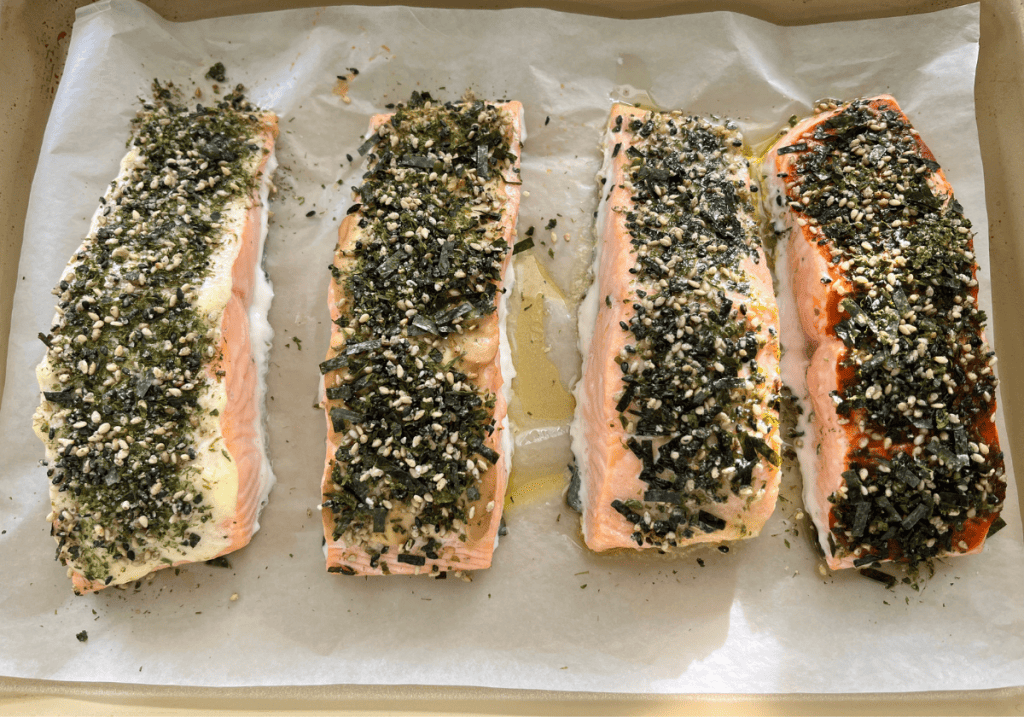
Bake for 10-15 minutes depending on the thickness of your fillet.
Hint: If you grease your parchment paper of baking sheet, the salmon skin won’t stick to it. If you don’t grease your parchment paper, like I did not, the salmon skin sticks. When you pick up the fillet to serve, the skin will stay on the paper and you’ll have a skinless salmon fillet on the plate.
Cooking Tip: A kitchen thermometer is the best way to tell if the fish is cooked through. 145 degrees F for well done or 125 degrees F for medium. Otherwise you can gently push on the top. If it feels firm and you can’t really push down, it’s cooked. If you can push down gently, it’s still medium rare. You can also look for the white albumen oozing out of the sides which is a sign of well doneness.
Substitutions
- Make your own Furikake Seasoning – If you don’t have a premade furikake, you can easily make your own with some seaweed sheets (nori), salt, sugar, and toasted sesame seeds.
- Wasabi paste – Like it spicy? Use a thin layer of wasabi paste on the salmon instead of mayo or mustard.
- Butter/Vegan Butter – Prefer mild? Use softened butter as the binding agent instead of mayo or mustard.

Variations
- Steelhead Trout – This recipe would work well with other strongly flavored fish such as tuna, swordfish, or mackerel. Steelhead trout isn’t as strongly flavored but looks just like salmon with its orange color. Due to its milder flavor, it really benefits from a seasoning punch like furikake.
- Vegetarian with Avocado – Feeding plant based friends? This would be just about amazing on a baked avocado half. Remove the skin, cut into slices, flatten slightly so it forms a sliced avocado patty, and proceed with the recipe. Reduce cooking time to 5-7 minutes in the oven.
- Make it crunchy – Mixed some crushed potato chips into the furikake seasoning for a crispy topping.
- Choose your own adventure – It doesn’t have to be the traditional mayonnaise or non-traditional mustard all the time. Vary the “glue” underneath the furikake by using fun combinations like sriracha+honey, wasabi+butter, or mayo+mustard.
For another variation of Japanese baked salmon, check out this recipe for Japanese baked salmon.

Equipment
No special equipment is required except for a baking sheet and something to brush the salmon with like a pastry brush or just a spoon works too.
Storage
Once the salmon is cooked, store up to three days in the fridge. It tastes great cold out of the fridge, or you can even reheat it in the air fryer.
You could freeze it once cooked, but this dish comes together quickly enough that you really don’t need a lot of lead time to make it again.
Top tip
What will make or break this dish is the quality of the salmon you buy. King salmon will be fatty and moist; coho or sockeye salmon will be a little drier and less moist; while Atlantic farmed salmon will be somewhere in between.
FAQ
Furikake salmon cooks very well in the air fryer. Despite the powerful fan and constant circulation of hot air, the furikake sticks to the salmon fillet and doesn’t fly around the air fryer. It will cook more quickly than in a regular oven, so reduce the cooking time check on the salmon to make sure it’s not overcooked.
A kitchen thermometer is the best way to tell if the fish is cooked through. 145 degrees F for well done or 125 degrees F for medium. Otherwise you can gently push on the top of the fillet. If it feels firm and you can’t really push down, it’s cooked. If you can push down gently, it’s still medium rare. You can also look for the white albumen oozing out of the sides which is a sign of well doneness.
Related
Looking for other seafood recipes? Try these:
Pairing
These are my some of my favorite dishes to serve with this recipe:
Furikake Salmon
Ingredients
- 1 1/2 lb salmon fillets with or without skin, See Note 1
- 1 1/2 Tb mayonnaise or Dijon mustard See Note 2
- 3 Tb furikake seasoning
Instructions
- Preheat the oven to 350 degrees F. Lay the salmon fillets onto a baking sheet, skin side down. Pat dry if they're very wet.
- Brush the top of the fillets with the "glue" of your choice, traditionally mayo but I like using Dijon mustard.
- Top each fillet with the furikake seasoning. Spread as evenly as possible over the top.
- Bake for 10-15 minutes depending on the thickness of your fillet. The USDA recommends cooking fish to an internal temperature of 145 degrees F, which will be well done. A temperature of 125 degrees F would yield medium cooked salmon.
Food safety
- The US Food and Drug Administration recommends cooking seafood to a minimum temperature of 145 °F. This would make for well done salmon.
- Don’t leave seafood sitting out at room temperature for extended periods.
- Never leave food while it is cooking unattended.
- Use oils with high smoking point to avoid harmful compounds.
- Always have good ventilation when using a gas stove.
See more guidelines at USDA.gov.
Fortune Cookie 🥠
Even a fool has at least one talent.
Japanese Proverb
Lucky Cat 🍀 🐈

I trust the Universe to send me the right people at the right time.



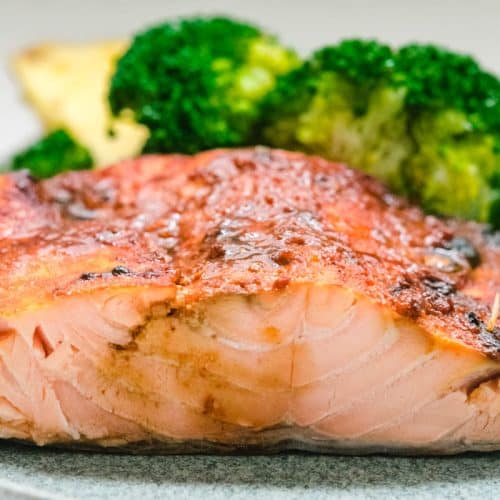


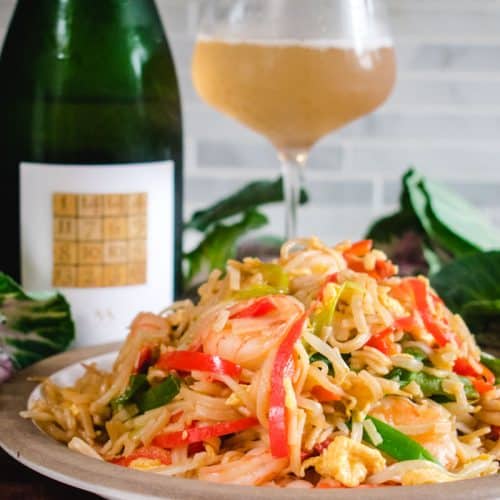
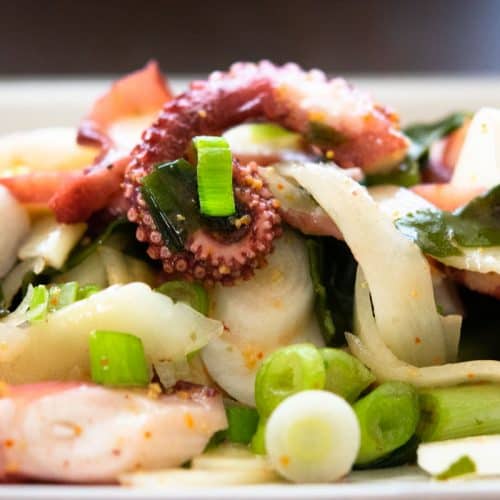
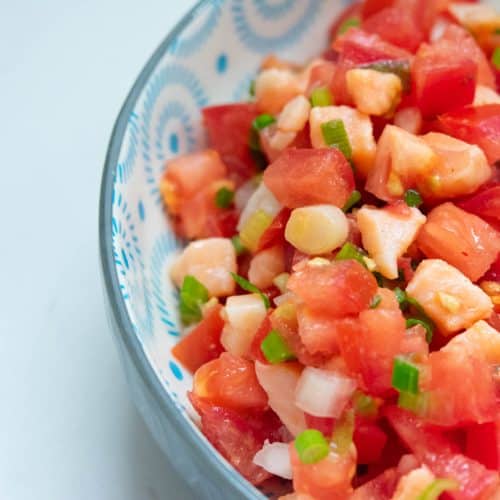
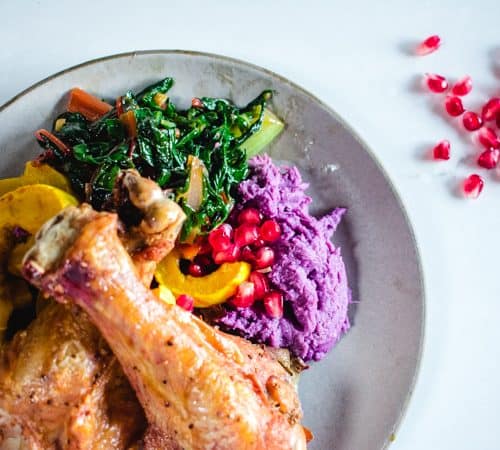

Leave a Reply